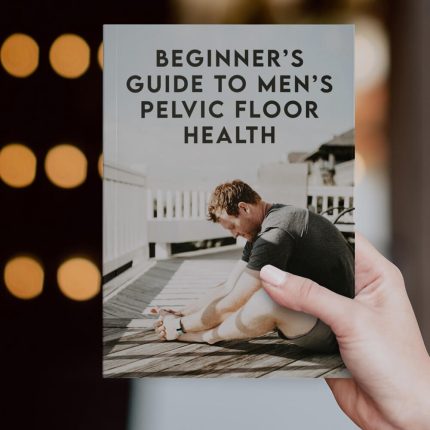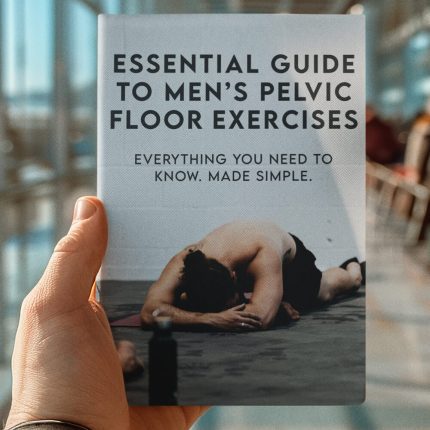
Pelvic Floor Therapy
What is the Men's Pelvic Floor?

Ever wondered if your pelvic floor could be the unsung hero of your manhood, silently supporting everything from your abs to your, well, “downstairs” performance? The men’s pelvic floor is a powerhouse of muscles and tissues that play a crucial role in everything from maintaining bladder control to enhancing your athletic performance and even contributing to your sexual prowess. Buckle up as we dive into a no-nonsense, sometimes hilarious, yet thoroughly informative journey on what the men’s pelvic floor is, how to give it some love, and why caring for it can seriously boost your overall well-being.
Quick Links to Useful Sections
- So, What Exactly Is the Men’s Pelvic Floor?
- Anatomy and Function: The Nitty-Gritty of Your Pelvic Core
- The Key Functions
- Why Men’s Pelvic Floor Health Matters
- Common Men's Pelvic Floor Issues and How to Spot Them
- Urinary Incontinence
- Pelvic Pain
- Erectile Dysfunction
- Lumbar Instability and Poor Posture
- Pelvic Floor Exercises for Men: Get Your Core Game On
- Kegel Exercises for Men
- Reverse Kegels
- Functional and Integrated Core Workouts
- Integrative and Holistic Approaches: More Than Just Exercise
- Conventional Therapies
- Complementary Therapies
- Mind-Body Techniques
- Nutritional Support
- The Mind-Body Connection: Why Zen Isn’t Just for Yogis
- Nutrition and Lifestyle: Feeding the Mighty Pelvic Floor
- Embrace an Anti-Inflammatory Diet
- Prioritize Hydration
- Regular Physical Activity
- Sleep and Stress Management
- Real-Life Transformations: Men's Pelvic Floor Success Stories
- The Athlete’s Comeback
- A New Lease on Intimacy
- The Everyday Warrior
- Crafting Your Personalized Pelvic Floor Health Plan
- Step 1: Comprehensive Self-Assessment
- Step 2: Define Your Goals
- Step 3: Build a Multi-Faceted Routine
- Step 4: Create a Daily Schedule
- Step 5: Monitor and Tweak
- Resources and Community Support: Your Next Steps
- Men’s Pelvic Floor FAQs: Your Questions, Answered
- Your Next Step Toward a Healthier, Empowered You
So, What Exactly Is the Men’s Pelvic Floor?
The men’s pelvic floor is a complex network of muscles, ligaments, and connective tissues located between your pubic bone and tailbone. Think of it as your body’s internal trampoline or a sturdy hammock that supports key pelvic organs such as the bladder, bowel, and, in a rather important bonus role, the reproductive organs. This muscle group is responsible for controlling the release of urine, stabilizing your core, and even playing a part in sexual health.
Unlike the glitzy gadgets you use every day, the pelvic floor operates quietly in the background, making sure everything works as it should. When functioning optimally, this muscle group not only contributes to a solid core but also assists in boosting your posture, athletic performance, and overall strength. Lose some of that pelvic floor power, however, and you might start noticing leaks, pain, or less impressive performance in the bedroom.
Anatomy and Function: The Nitty-Gritty of Your Pelvic Core
Let’s break it down with a metaphor that even your tech-savvy brain can appreciate: imagine a suspension bridge that holds up a bustling city. The cables that keep the bridge steady? Those are your pelvic floor muscles. In men, these muscles include the puborectalis, pubococcygeus, and iliococcygeus, names that might sound like code for secret superhero squads, and in many ways, they are.
The Key Functions
Your pelvic floor muscles are involved in:
Your pelvic floor affects how you move, how you use the bathroom, and how sex feels, yet most men are never taught how it works. This essential guide explains your pelvic floor in plain language and gives you a simple plan to relax, strengthen, and look after it at home.
Youll Learn How To:
- Understand what your pelvic floor does for bladder control, posture, and sex
- Spot signs of tension, weakness, and poor coordination
- Use breathing, reverse Kegels, and classic Kegels safely
- Improve habits for sitting, lifting, sport, sleep, and stress
Whats Inside: friendly explanations, safety guidelines, daily drills, sex function tools, flare up plans, and a complete twelve week program with trackers.
Perfect For: men of all ages who want less pelvic tension, fewer leaks, better comfort on the toilet, and more confidence in movement and in the bedroom.
- Bladder and Bowel Control: They act as a valve, helping you hold in urine until you find a bathroom and controlling bowel movements.
- Core Stability: By supporting your lower back and abdomen, they contribute to better posture and a stronger core.
- Sexual Health: A strong pelvic floor can enhance sexual performance, contributing to stronger erections and improved orgasmic control.
So, if you’ve been ignoring this hidden powerhouse, perhaps in favor of crunches or gym selfies, it’s time to refocus and give your pelvic floor some much-deserved attention.
Why Men’s Pelvic Floor Health Matters
When it comes to health, there’s more to being manly than just putting on a good pair of socks or growing a killer beard. Your pelvic floor is at the heart of a healthy, well-functioning body. Here’s why paying attention to this area is a no-brainer:
- Urological Health: A robust pelvic floor helps prevent or manage issues such as urinary incontinence, frequent urination, and even issues related to prostate health.
- Intimacy and Sexual Performance: Enhanced pelvic muscle control can improve erection strength and sexual stamina, which means a better performance on date night (or any night).
- Posture and Core Strength: A strong pelvic floor supports the lower back and core, helping you maintain proper posture and reduce the risk of chronic back pain.
- Enhanced Athletic Performance: Whether you’re hitting the gym or running that extra mile, a stable pelvic core contributes to overall body balance and efficiency.
In short, neglecting your pelvic floor is like ignoring the foundation of a skyscraper. Without it, even the strongest exterior (or those biceps you’ve worked so hard on) can’t compensate for a shaky core.
Common Men's Pelvic Floor Issues and How to Spot Them
It’s not always fun to talk about leaks, pain, or unexpected noises, but recognizing the signs of pelvic floor dysfunction is the first step toward reclaiming your core strength. Here are some issues men might face:
Urinary Incontinence
No one wants that embarrassing moment when you laugh a little too hard and, oops, there goes a drip. Urinary incontinence can be a sign that your pelvic floor muscles are not doing their job as effectively as they should.
Pelvic Pain
Chronic pelvic pain may not have you wincing in public, but it can definitely affect your quality of life. This discomfort might stem from muscle tension, nerve irritation, or inflammation within the pelvic region.
Erectile Dysfunction
Believe it or not, your pelvic floor muscles play a role in maintaining erections. Weak or uncoordinated muscles can contribute to performance issues. Strengthening your pelvic floor might just help you reclaim that youthful vigor.
Lumbar Instability and Poor Posture
A neglected pelvic floor can disrupt your core stability, leading to lower back pain, poor posture, and even increased risk of injury during physical activities.
If you’ve noticed any of these signs or if you’re simply curious about boosting your performance, diving into pelvic floor exercises could be a game-changer.
Pelvic Floor Exercises for Men: Get Your Core Game On
Let’s face it: workouts are the new cool, and this one’s tailor-made for every guy who wants to build more than just six-pack abs. Focusing on pelvic floor exercises can sound a bit intimate, but trust us, these exercises are a sure-fire way to boost your overall performance.
Your pelvic floor affects how you move, how you use the bathroom, and how sex feels, yet most men are never taught how it works. This essential guide explains your pelvic floor in plain language and gives you a simple plan to relax, strengthen, and look after it at home.
Youll Learn How To:
- Understand what your pelvic floor does for bladder control, posture, and sex
- Spot signs of tension, weakness, and poor coordination
- Use breathing, reverse Kegels, and classic Kegels safely
- Improve habits for sitting, lifting, sport, sleep, and stress
Whats Inside: friendly explanations, safety guidelines, daily drills, sex function tools, flare up plans, and a complete twelve week program with trackers.
Perfect For: men of all ages who want less pelvic tension, fewer leaks, better comfort on the toilet, and more confidence in movement and in the bedroom.
Kegel Exercises for Men
Kegels aren’t just for women! Men can benefit hugely from Kegels, which involve contracting and relaxing the pelvic floor muscles. Here’s how to do it right:
- Find Your Muscles: The first step is simply identifying your pelvic floor muscles. Try stopping your urine midstream (only as a test, not as your daily workout) to get a feel for where those muscles are located.
- Contract and Hold: Once identified, contract the pelvic muscles tightly for about 3-5 seconds, then relax for an equal amount of time. Repeat this cycle 10-15 times, multiple times a day.
- Mix It Up: Work on both slow and quick contractions to stimulate different muscle fibers. Slow contractions help build endurance, while quick snaps promote agility.
With consistency, these exercises can strengthen your pelvic floor, potentially improving everything from bladder control to your bedroom performance.
Reverse Kegels
Ever wondered if you could really “actively relax” your pelvic floor? Reverse Kegels focus not on contracting but on purposely lengthening the muscles. This exercise can help relieve excessive tension in the pelvic region, common in those who may always be a bit too “tight” due to stress or overexertion.
Functional and Integrated Core Workouts
Your pelvic floor doesn’t work in isolation, integrating core, glute, and lower back exercises can provide a complete picture of fitness. Planks, bridges, and Pilates-style routines all offer fantastic ways to indirectly recruit your pelvic muscles while strengthening your overall core.
The secret is to keep these workouts fun and varied, so mix in a little challenge and maybe a customizable playlist for full-on motivation!
Integrative and Holistic Approaches: More Than Just Exercise
Sure, dedicated pelvic floor exercises are crucial, but a holistic approach combines targeted physical workouts with nutrition, lifestyle adjustments, and mind-body practices. By embracing a comprehensive strategy, you can support your pelvic floor across multiple dimensions.
Conventional Therapies
Traditional pelvic floor therapy is not just about doing reps; it involves professional guidance, often using techniques like biofeedback to ensure you target the correct muscles. If you’re encountering persistent issues, a consultation with a pelvic floor physical therapist can provide you with customized exercises and manual therapies to enhance muscle function.
Complementary Therapies
Think of these as your pelvic floor’s sidekicks. Treatments such as massage therapy, acupuncture, or even chiropractic care can help alleviate tension, improve blood flow, and boost overall function. They work hand in hand with your exercise routine, offering a holistic way to relieve pain and restore balance.
Mind-Body Techniques
Stress, anxiety, and even everyday pressures can make your pelvic muscles contract and tighten, reducing their overall effectiveness. Integrating mindfulness, meditation, and deep breathing exercises can help relax your body, making it easier to activate your pelvic floor correctly during workouts.
Nutritional Support
A balanced diet provides the anti-inflammatory and muscle-repair nutrients that your body needs to recover from workouts and support long-term pelvic health. Incorporate lean proteins, colorful fruits and vegetables, healthy fats, and whole grains into your diet. Staying hydrated is also key, as water helps maintain the elasticity and function of your tissues.
Your pelvic floor affects how you move, how you use the bathroom, and how sex feels, yet most men are never taught how it works. This essential guide explains your pelvic floor in plain language and gives you a simple plan to relax, strengthen, and look after it at home.
Youll Learn How To:
- Understand what your pelvic floor does for bladder control, posture, and sex
- Spot signs of tension, weakness, and poor coordination
- Use breathing, reverse Kegels, and classic Kegels safely
- Improve habits for sitting, lifting, sport, sleep, and stress
Whats Inside: friendly explanations, safety guidelines, daily drills, sex function tools, flare up plans, and a complete twelve week program with trackers.
Perfect For: men of all ages who want less pelvic tension, fewer leaks, better comfort on the toilet, and more confidence in movement and in the bedroom.
By addressing the physical, mental, and nutritional ingredients of health, you can create an environment where your pelvic floor thrives.
EXPLORE OUR EXPERT MEN'S PELVIC FLOOR GUIDES WITH HIDDEN TIPS AND TRICKS
👨💻 Men's Pelvic Floor Book Store (Instant Download) 👨💻
The Mind-Body Connection: Why Zen Isn’t Just for Yogis
Let’s be real, stress is the arch-nemesis of a healthy pelvic floor. When you’re stressed, your body tenses up, and your pelvic muscles are not exception. The mind-body connection is essential in ensuring these muscles can work in harmony.
Try integrating activities like mindfulness meditation, yoga, or even simple breathing exercises into your daily routine. Think of these practices as a way to give your body a mini-vacation. They can help release tension, lower stress hormones, and create a more receptive environment for your pelvic floor exercises.
Over time, the benefits extend well beyond relaxation, a calm mind can lead to better muscle coordination, enhanced focus during workouts, and an overall boost in the effectiveness of your pelvic floor strengthening routine.
Nutrition and Lifestyle: Feeding the Mighty Pelvic Floor
You are what you eat, and so is your pelvic floor. A nutrient-rich diet paired with a lifestyle that champions regular physical activity and stress management is crucial for sustaining pelvic floor health.
Embrace an Anti-Inflammatory Diet
Include plenty of colorful fruits, leafy greens, whole grains, and omega-3 rich foods like salmon and walnuts to help quell inflammation. Foods that reduce inflammation allow your muscles to function optimally and repair themselves after those tough workouts.
Prioritize Hydration
Water is essential not only for your overall health but for keeping your muscles pliable. Staying hydrated ensures that your tissues remain flexible and responsive, which is particularly important when engaging in pelvic floor exercises.
Regular Physical Activity
Incorporate low-impact exercises that complement your targeted pelvic floor routines. Activities such as walking, swimming, or even an occasional dance-off in your living room can enhance blood flow and contribute to overall core stability.
Sleep and Stress Management
A good night’s sleep and effective stress-management strategies are non-negotiable. Aim for 7-9 hours of quality sleep each night. Whether it’s reading a book, practicing relaxation techniques, or just unplugging from screens, these habits help your body recover and keep those pelvic muscles functioning at their best.
Integrating these lifestyle choices not only boosts your pelvic floor health but also contributes to an overall healthier, more balanced version of you.
Real-Life Transformations: Men's Pelvic Floor Success Stories
While the science and exercises are all well and good, sometimes nothing beats real-life stories to illustrate the powerful impact of a well-cared-for pelvic floor. Let’s hear from a few guys who turned things around:
The Athlete’s Comeback
Mark, a semi-pro athlete, began experiencing lower back pain and decreased performance during his training sessions. After learning about the importance of pelvic floor strength and incorporating specific exercises into his regimen, alongside core stabilization and targeted stretching, Mark not only regained his athletic edge but also reported improvements in endurance and recovery. His story is a testament to how a dedicated focus on pelvic floor health can elevate even the most rigorous performance demands.
A New Lease on Intimacy
James, a 38-year-old professional, noticed a decline in his sexual performance and occasional issues with bladder control. After consulting with a pelvic floor therapist and embracing a combination of Kegel and reverse Kegel exercises, along with mindfulness techniques to manage stress, James experienced a remarkable turnaround. His enhanced pelvic control translated to better intimacy, renewed confidence, and an overall improved quality of life.
The Everyday Warrior
Then there’s Ben, a busy millennial juggling a high-pressure job and an active social life, who began to experience pelvic discomfort and core instability. With his newfound dedication to integrative exercises, mindful breathing routines, and adjusted nutritional habits, Ben managed to restore his core strength and alleviate his discomfort. His journey serves as an inspiring reminder that everyday stressors need not dictate your pelvic health destiny.
These narratives highlight that no matter your age or lifestyle, addressing the strength and function of your pelvic floor can lead to transformative improvements in both physical and mental health.
Crafting Your Personalized Pelvic Floor Health Plan
Ready to level up your pelvic floor game? Crafting a tailored plan is key to ensuring you target your unique needs. Here’s how you can create a customized road map to pelvic floor mastery:
Step 1: Comprehensive Self-Assessment
Begin by checking in with yourself (and possibly a healthcare professional). Identify any symptoms like urinary leakage, lower back pain, or discomfort during physical activities. A thorough evaluation, including a consultation with a pelvic floor specialist, can provide a baseline for your workout and wellness plan.
Step 2: Define Your Goals
What are you aiming for? Whether it’s improving bladder control, enhancing your core stability, or boosting sexual performance, setting clear and achievable goals will help keep your progress on track.
Step 3: Build a Multi-Faceted Routine
Your plan should merge targeted pelvic floor exercises with complementary activities:
- Dedicated Kegel and reverse Kegel routines.
- Core workouts integrating planks, bridges, and Pilates moves.
- Mindfulness and breathing exercises to reduce stress and enhance muscle control.
- Complementary therapies such as massage or acupuncture if needed.
- A balanced diet filled with anti-inflammatory and muscle-supporting foods.
Step 4: Create a Daily Schedule
Consistency is your secret weapon. Set aside specific times for exercise, relaxation, and meal planning. Use digital calendars, reminder apps, or even a good old-fashioned notebook to keep you organized.
Step 5: Monitor and Tweak
Keep a journal to log your workouts, note any changes in symptoms, and monitor improvements. Periodically revisit your plan with your healthcare provider to make adjustments as your body evolves.
Crafting your personalized plan is a dynamic process, be open to experimentation, stay patient, and celebrate every win, no matter how small.
EXPLORE OUR EXPERT MEN'S PELVIC FLOOR GUIDES WITH HIDDEN TIPS AND TRICKS
👨💻 Men's Pelvic Floor Book Store (Instant Download) 👨💻
Resources and Community Support: Your Next Steps
Embarking on a journey to improved pelvic floor health doesn’t have to be a solo mission. There is a wealth of resources and communities dedicated to men’s pelvic health where you can gather tips, share experiences, and get motivated:
Online Forums and Social Media Groups: Sites like Reddit, Facebook communities, and specialized health forums offer valuable advice and peer support. These are great places to ask questions, share progress updates, and discover new workout ideas or success stories from other men.
Professional Guidance: Don’t hesitate to seek out a pelvic floor physical therapist or men’s health specialist. Professional guidance can provide you with tailored strategies that align with your unique health goals.
Educational Platforms: Websites, blogs, and YouTube channels with trusted experts can walk you through proper techniques and offer evidence-based advice. Following credible sources not only ensures accuracy but also empowers you with the knowledge to make informed decisions about your health.
Local Support Groups: Check with your local health centers or gyms for workshops and group classes focused on pelvic floor health. These sessions blend education, experience, and community support for an engaging way to stay committed on your wellness journey.
Remember, your journey to a stronger pelvic floor is part of a broader movement toward holistic male wellness. Lean on these resources and communities for tips, motivation, and that occasional high-five when you hit a new milestone.
Men’s Pelvic Floor FAQs: Your Questions, Answered
Let’s demystify this vital area with some frequently asked questions that many men find themselves asking about pelvic floor health:
1. What is the men’s pelvic floor?
It’s a network of muscles and tissues that support the bladder, bowels, and reproductive organs. Think of it as a natural support system that keeps everything in place and functioning properly.
2. Why is pelvic floor health important for men?
A strong pelvic floor aids in bladder and bowel control, enhances core stability, and can improve sexual performance by contributing to stronger erections and better orgasm control.
3. What are the common signs of pelvic floor dysfunction in men?
Some common signs include urinary incontinence, pelvic pain, lower back discomfort, and issues with sexual performance. Recognizing these symptoms early can guide you to seek the right help.
4. How do I start exercising my pelvic floor?
Begin with simple Kegel exercises, contract the muscles you’d use to stop urination, hold it for a few seconds, and then relax. Consistency is key, and combining these with core workouts can yield even better results.
5. Can pelvic floor exercises help with erectile dysfunction?
Yes, by strengthening the muscles that support blood flow in the pelvic region, many men have experienced improvements in erectile function and overall sexual health.
6. How long does it take to see improvements?
Results can vary, but many men notice improvements within a few weeks to a few months of consistent exercise and lifestyle adjustments.
7. Are there any risks associated with pelvic floor exercises?
When done correctly, pelvic floor exercises are generally safe. However, improper technique or overexertion may lead to muscle strain. Consulting a specialist can help you fine-tune your routine.
8. Can I practice these exercises at home?
Absolutely! Many pelvic floor exercises can be done at home, making it easy to incorporate them into your daily routine alongside other workouts.
9. Should I combine these exercises with other forms of physical activity?
Definitely. Integrating core stability workouts, flexibility routines, and even aerobic exercises can complement your pelvic floor training and enhance overall health.
10. Where can I find additional information and support?
Online communities, professional guidance from pelvic floor therapists, and reputable health websites are excellent sources of information and support to help you on your journey.
Your Next Step Toward a Healthier, Empowered You
Taking charge of your pelvic floor health isn’t just about preventing leaks or lifting heavy objects, it's about reclaiming a sense of power, stability, and overall well-being. Embrace the challenge, add some fun to your workouts, and remember that a thriving pelvic floor supports every aspect of your life, from performance in the gym to confident, intimate moments.
If you’re ready to explore holistic changes that not only elevate your physical strength but also contribute to mindfulness, improved posture, and a dash of swagger, now is the perfect time to start. With a few dedicated exercises, dietary tweaks, and a commitment to living a balanced and active lifestyle, your pelvic floor can become your secret weapon in achieving a healthier, happier life.
Whether you’re a gym warrior, a weekend adventurer, or simply someone looking to improve your overall vitality, remember: your pelvic floor is the foundation of robust health. Embrace the journey, seek out the right resources, and let every rep, every mindful breath, and every nourishing meal fuel your path to empowerment. The time to invest in your core is now, step up, get active, and let your inner strength shine.
Your pelvic floor affects how you move, how you use the bathroom, and how sex feels, yet most men are never taught how it works. This essential guide explains your pelvic floor in plain language and gives you a simple plan to relax, strengthen, and look after it at home.
Youll Learn How To:
- Understand what your pelvic floor does for bladder control, posture, and sex
- Spot signs of tension, weakness, and poor coordination
- Use breathing, reverse Kegels, and classic Kegels safely
- Improve habits for sitting, lifting, sport, sleep, and stress
Whats Inside: friendly explanations, safety guidelines, daily drills, sex function tools, flare up plans, and a complete twelve week program with trackers.
Perfect For: men of all ages who want less pelvic tension, fewer leaks, better comfort on the toilet, and more confidence in movement and in the bedroom.
Curious About Your Pelvic Floor? Explore our curated collection of insightful articles to learn more and take charge of your health.
- Pelvic Floor Basics
- Pelvic Floor Exercises & Workouts
- Pelvic Floor Kegel Exercises: Techniques & Benefits
- Advanced Pelvic Floor Workouts
- Pre/Post-Natal Pelvic Floor Routines
- Pelvic Floor Exercises for Men
- Pelvic Floor Therapy Techniques
- At-home vs Professional Pelvic Floor Therapy Options
- Diet & Lifestyle for a Healthy Pelvic Floor
- Pelvic Floor Health & Wellness
- Specialized Pelvic Floor Conditions & Treatments
Now back to the main article!

















